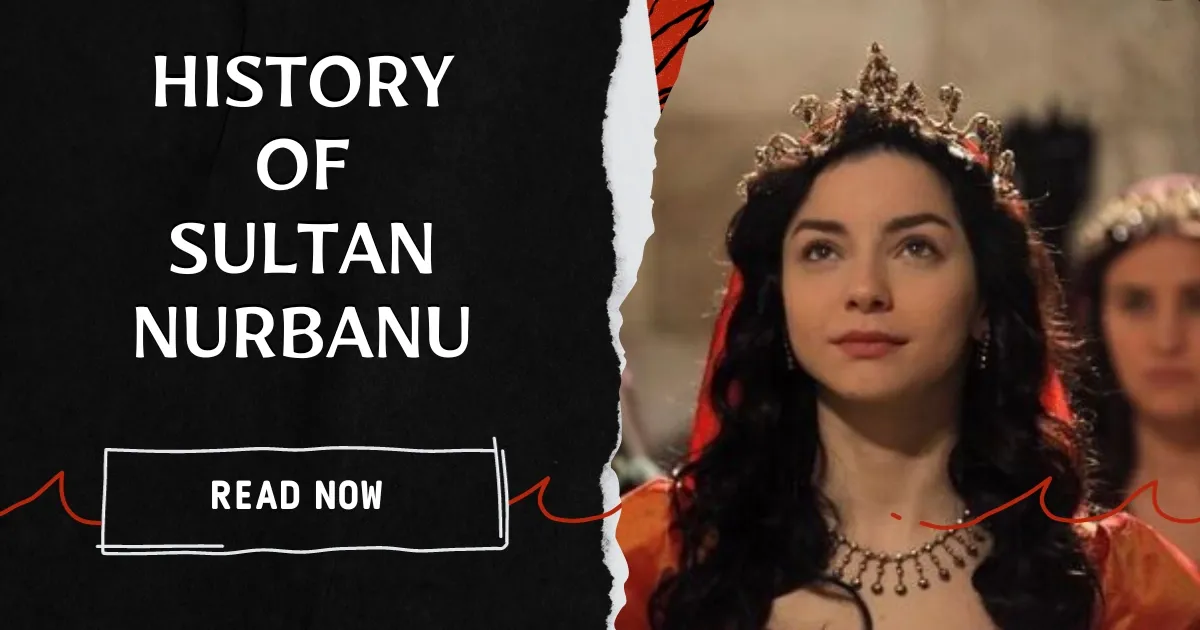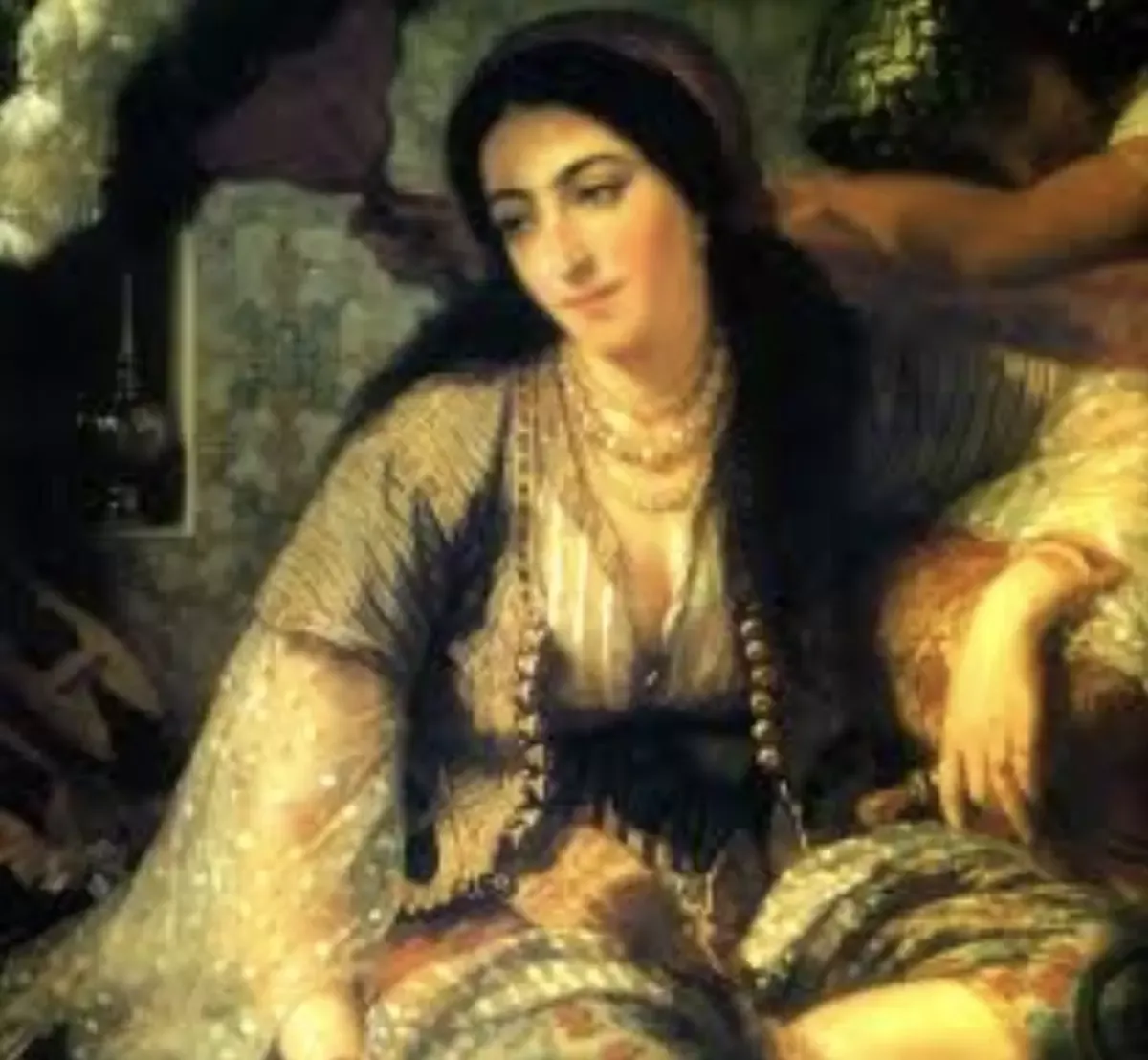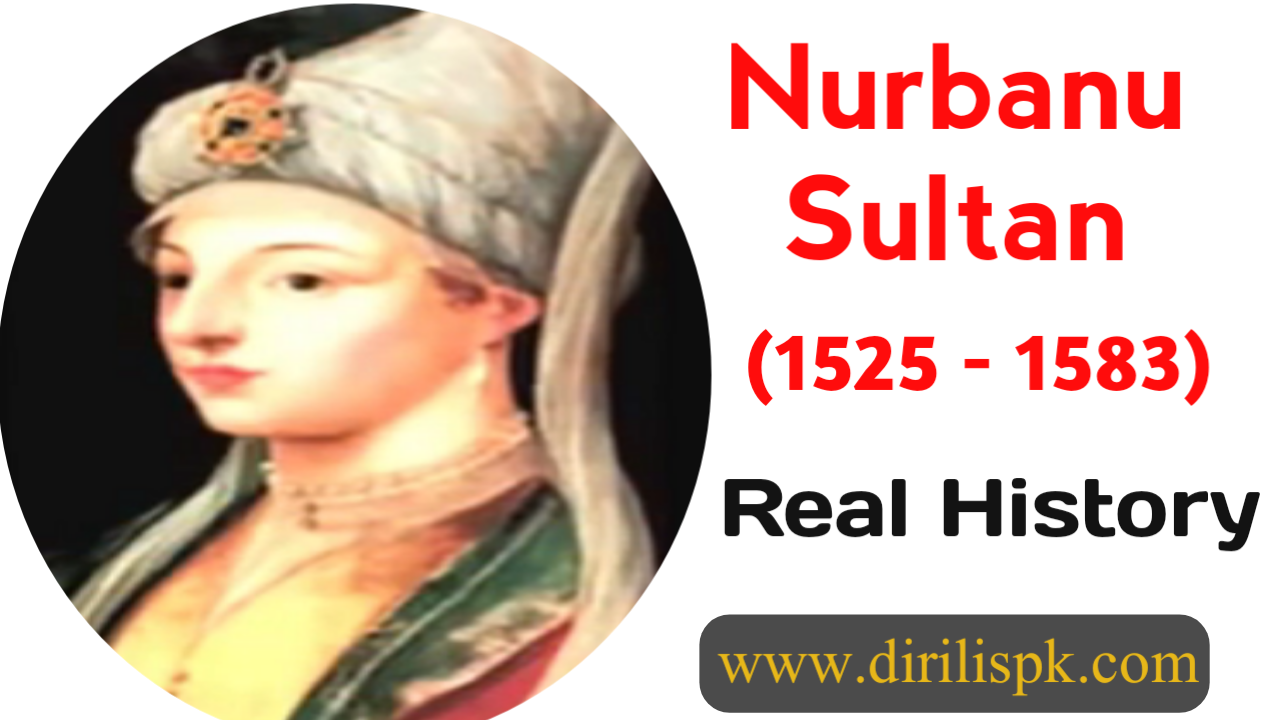Welcome To Dirilispk. Today i am sharing here the complete History of Nurbanu Sultan. If you like this article then please like and share with others. Thanks
Nurbanu Sultan was one the most powerful figures in the Ottoman Empire. She was the favorite concubine and eventual wife of Selim II, and mother of Sultan Murad III. Nurbanu Sultan was one of the great queens of ottoman history. Her compassion for the poor in the Ottoman Empire drove her to be a philanthropist of great renown.
Nurbanu Sultan History :
Her background is quite unclear, like every woman in the harem. Some argued that she belonged to Jewish family. According to some other historians, she was born on 1525 in Paros, an island of current Greece at Nicolo Vanier House who was a duke. At that time Paros was controlled by Venice. The Nurbanu, herself, would often say she was of Venetian patrician descent. She was captured by Ottoman admiral Hayreddin Barbarossa in a battle and was sent to Istanbul as a gift. She was only 12 years old at that time. It wasn’t easy for her to go from a noblewoman to a slave. Before embracing Islam, her previous name was Cecelia Venier Baffo While according to some other historians her name was Rachel.Who is Sultan Nurbanu in History:
She caught the eye of Hurrem Sultan and was able to impress her with her intelligence. Due to her praiseworthy morals and manners, Hurrem Sultan gave her the name “Afife Nurbanu”. Very soon, she became one of the concubines for Prince Selim and was sent Manisa. She was beautiful and intelligent and captured Prince Selim’s eye. Nurbanu gave birth to 4 daughters and 1 son of Prince Selim. During her time in the Prince’s harem in Manisa, Nurbanu maintained good relationship with Hurrem Sultan. Nurbanu had been the head of his princely harem at Manisa. However, when Selim ascended to the throne, as Hurrem sultan already had died, the position of head of the imperial harem, was granted to Selim's elder sister Mihrimah Sultan. But due to her intelligence, Sultan Selim appointed her as his advisor. He used to take her advice in government affairs. |
| Who is Sultan Nurbanu in History |
As Sultan Selim loved her too much, shortly before his death, he married Nurbanu, and she became his queen. When Selim died in 1574,his son Murad was in Mansia serving as governor. At that time, Nurbanu hide the news of Selim’s death until his son arrived in Istanbul. Due to this act Murad III became next Sultan. For this reason, Murad greatly respected and relied on his mother. Like his father, Murad also used to take her (Nurbanu) advice in government affairs. Nurbanu became Valide Sultan (queen mother) and the most powerful woman in the Ottoman Empire. As queen mother, Nurbanu was a shrewd diplomat.
History Of Sultan Nurbanu:
She not only protected her Ottoman subjects, but she also rescued slaves and protected Jewish merchants. She maintained good relationships with Venice and France. She invited French Queen Catherine to send an embassy to Istanbul to maintain their relationship and renewed French trading privileges within the empire It is said that during her nine years of regency (1574–1583), her politics were so pro-Venetian that she was hated by the Republic of Genoa. Some have even suggested that she was poisoned by a Genoese agent. According to some historian she played a vital role in keeping peace with Venice. |
| History Of Sultan Nurbanu |
Nurbanu was also known for her charitable works. She built mosques, schools, bathhouses, and soup kitchens. The most important ones are the Atik Valide Mosque complex which was built in Istanbul. The complex was composed of a mosque, a madrasah, a dervish lodge, a primary school, a soup kitchen for poor, a caravansary, printing house, a school for Quran reciters, a Turkish Bath and a hospital. Nurbanu also became the first woman to establish libraries within the capital of Istanbul. Nurbanu died at the age of 58 in Istanbul on December 7, 1583. She was buried next to Selim II in his mausoleum in the courtyard of Hagia Sophia in Istanbul thus becoming the first wife of a Sultan to receive the honor of being laid to rest next to her spouse.
How did Nurbanu Sultan Died?
Nurbânû Sultan passed away on 22 Zilkade 991 (December 7, 1583) in her palace in Yenikapı (Bahçe palace). In the funeral procession, his son Murad-III was personally present; He followed her body to Fatih Mosque in his mourning dress and performed his prayer. His funeral is in Hagia Sophia. Nurbânû Sultan, who was buried in Selim's tomb, is known for the works such as mosques, masjids, soup kitchens and baths he built in Mercan, Alemdağ and Langa in Istanbul, as well as the Atik Valide Sultan Mosque and Social Complex he built in Üsküdar. Her library in this complex is the first library established by a woman in the Ottomans. The stone needed during the construction of this mosque and social complex was supplied from places close to Istanbul such as Iznik and Gallipoli, and the wood was supplied from Sapanca and Iznik. The tax revenues of the Yeniil district, which covers a large area in the southern part of Sivas, were donated to provide income for the mosque and social complex. For this reason, the Yeniil district was first assigned to the mother-sultan, and she dedicated this place to the mosque and social complex in Üsküdar. The fact that a significant part of the population of the Yeniil district is nomadic Turkmens has caused the district to be called "Türkmân-ı Yeniil". The tax revenues of the district were donated to the mother sultan's mosque and social complex in Üsküdar, which led to the Turkmens here being occasionally mentioned as Üsküdar Turkmens in the documents.
Nurbanu Sultan Childrens:
The details of all the children of Nurbanu Sultan are shared here below. Nurbanu Sultan had one son and three daughters. Details of which are:
1st Child: Prince Murad (Murad III)
He was born in Manisa in 1546. He is the 12th Ottoman Sultan. He died in Istanbul in 1595.
2nd Child: Shah Sultan
She was born in Konya in 1544. She was married to Çakırcıbaşı Hasan Efendi. When her first husband died, she was married to Silahtar Ali Pasha. She died in Istanbul in 1577.
3rd child: Fatma Sultan
She was born in Manisa in 1548. She was married to the Ottoman Grand Vizier Kanijeli Siyavuş Pasha. She died in Istanbul in 1580.
4th child: Ismahan Sultan
She was born in Manisa in 1545. She was married to Grand Vizier Sokullu Mehmet Pasha. Her name is mentioned as İsmihan in some sources. She died in Istanbul in 1585.
What is Nurbanu Sultan's real name?
Nurbanu Sultan is among the most well-known sultans in history. Unknowns about the life of Nurbanu Sultan manage to be the subject of historical sources. Detailed information such as Nurbanu Sultan's real name and how old he died has been the subject of research by history enthusiasts.
Nurbanu Sultan; She was the Hasekisi of the Ottoman Sultan Selim II and the mother of Sultan Murad III. The real name of Nurbanu Sultan, also known as the bride of Haseki Hürrem Sultan, is Afife Nurbanu Sultan. There are various rumors about the origin of Nurbanu Sultan. Accordingly, it was recorded that Nurbanu Sultan's real name was Kali or Cecilia. According to these rumors, precise information about the real name of Afife Nurbanu Sultan could not be reached.
At what age did Nurbanu Sultan die?
It is said that Nurbanu Sultan was born in 1525 or 1530. Hürrem Sultan's daughter-in-law, Nurbanu Sultan, was taken to the palace by him and sent to education. In later times, she was given the name Nurbanu, which means radiant queen, by Hürrem Sultan. Nurbanu Sultan is said to have died on December 7, 1583 at the age of 53.
What is Nurbanu Sultan's Date of Birth?
When we look at the historical sources, we find two different information about the date of birth of Nurbanu Sultan. Based on this, it is said that the date of birth of Nurbanu Sultan is 1525 or 1530.
What is the date of death of Nurbanu Sultan?
The Hasekisi of the Ottoman Sultan Selim II and the mother of Sultan Murad III, Nurbanu Sultan was also the daughter-in-law of Haseki Hürrem Sultan. The date of Nurbanu Sultan's death is recorded as December 7, 1583 in the sources.
How Did Nurbanu Sultan Actually Die?
There is also a lot of information about the death of Nurbanu Sultan. According to this, Nurbanu Sultan actually died on December 7, 1583, during the reign of his son. Although there is no different information about his death in historical sources, some commentators have claimed that he died of poisoning.
Where is Nurbanu Sultan Tomb?
Nurbanu Sultan died on 7 December 1583 during the reign of his son. The funeral of Nurbanu Sultan was held in Fatih Mosque with a ceremony attended by the sultan, the grand vizier and the sheikh al-Islam on foot. The tomb of Nurbanu Sultan was buried in the mausoleum of Selim II in the garden of Hagia Sophia.
Where is Nurbanu Sultan originally from?
There are different interpretations of where Nurbanu Sultan was originally from. According to a rumor, Nurbanu Sultan was originally Venetian, while according to some rumors, he was originally Greek. Exact information about where Nurbanu Sultan was originally from is not found in historical sources.
Who is Nurbanu Sultan's wife?
Nurbanu Sultan entered the palace at an early age and started to receive education here. Nurbanu Sultan, who attracted the attention of Hürrem Sultan from the very first moment, was thought of as a wife to one of the princes. Nurbanu Sultan has been described in history as the wife of Selim II.
Who is Nurbanu Sultan's bride?
Hürrem Sultan's daughter-in-law, Nurbanu Sultan, was married to Selim II. The wife of Selim II, the mother of Murad III, was Safiye Valide Sultan, the daughter-in-law of Nurbanu Sultan. Although Murad III later had different wives, it is said that Nurbanu Sultan's daughter-in-law was Safiye Valide Sultan.
How many children does Nurbanu Sultan have?
How many children Nurbanu Sultan had from her marriage with Selim II has been among the questions investigated by history buffs. According to this, Nurbanu Sultan had 3 children, Murad III, Esmehan Sultan and Shah Sultan.

Extra History Of Nurbanu Sultan

Extra History Of Sultan Nurbanu:
It is stated that her real name was Cecilia, that she was born on the island of Para (Paros) in 1525-1530, that she was the daughter of Nicoló Venier, the Venetian administrator of the island, and Violante from the Baffo family, and that she was captured by Barbaros Hayreddin Pasha during the Islands expedition in 1537 and presented to the palace as a concubine. This identity is mistakenly attributed to his son III in some research. Murad's haseki is attributed to Safiye Sultan. However, the fact that he belonged to the Venier and Baffo families of Venice is based on the information given in the senate by Hasan Sergeant, whom Prince Selim sent to Venice on a secret diplomatic mission in October 1559, and is not confirmed by any other source. Another rumor about her origin states that, while she was the daughter of a Greek family from the Assumati village of the Venetian-administered Corfu island, she was captured at the age of seven during the war in October 1537 and her name was Kali.
Apart from this rumor, which seems to have been put forward later, it is also stated that he was a member of the Quartanis, a rich and noble family from Venice in Corfu (in 1574, S. Gerlach first reported that he was taken captive from the island of Corfu [p. 29, 71], and then Para. He writes that he was a Greek from the island [p. 334]). All this information is insufficient to shed light on his true identity (Arbel, XXIV [1992], pp. 241-259). Nurbânû, who seems to have come to the fore in the palace with her beauty and extraordinary intelligence, probably took part in Prince Selim's harem during his departure from Istanbul to Konya as a sanjak lord in 950 (1543), and after a while, the prince's first child, his daughter, was born here. In 953 (1546), while Selim was in Manisa as a prince, she gave birth to Murad, the heir to the throne. They also had three more daughters named Şah, Gevherhan and İsmihan. He made contact with the Venetians to support Prince Selim by highlighting his Venetian identity in Selim's struggle with his brother Bayezid.
In 974 (1566) Upon Selim's accession to the throne, she became the head of the harem as the mother of the heir to the throne, Sultan Murad (III). After her son's ascension in 982 (1574), her position in the palace became even stronger and she was known as the valide sultan. In documents referring to Murad, he began to be mentioned as "my mother sultan, my mother sultan, my mother my mother sultan". During his reign, the harem became an influential institution. He played an important role in the harem, and had a large say in the protection of the dynasty and the daily functioning and life of the harem.
Nurbanû's influence on the harem was influenced by her son III. Murad's great respect for him also played a role. Thus, the governorship of the sultanate reached a high status and became an important and powerful position of the dynasty. Nurbani's pocket money, which reached high amounts among both dynasty members and senior officials, is considered an indicator of this power. As the valide sultan, she was allocated 2000 silver coins per day. There is extensive information in the ambassador reports about Nurbânû Sultan's close political and diplomatic contact with the Venetians.
In 1583, the Venetian senate agreed to send him a gift worth 2000 Venetian gold coins for his useful services. According to another report, he prevented a possible Ottoman attack on Crete and warned Kaptanıderya Kılıç Ali Pasha not to declare war on Venice (Peirce, p. 296-297). It is also known that he corresponded with Catharine de Médicis, the queen mother of France. These correspondences included topics such as the development of good relations between the French palace and the Ottoman palace and the renewal of commercial agreements. It is understood that Nurbânû Sultan used Kira Ester Handali, who was of Jewish origin, for her personal affairs and that she also had a financial relationship with the Duke of Naxos, Joseph Nassi. Perhaps due to this network of relationships, rumors spread that he was of Jewish origin. Among his close men, Bâbüssaâde Ağası Gazanfer Ağa, companion Şemsi Pasha, Canfeda Hatun and Râziye Kadın, the powerful figures of the harem who have been with him since Manisa, come first.
Final Words:
If you like the post do not forget to share on social media. Thanks for your visit. Keep visiting our site for more and more fresh content.Read More:
x



















0 Comments